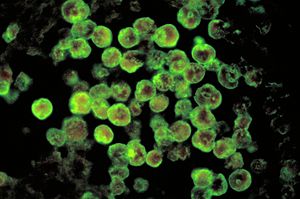
Primary amebic meningoencephalitis

Naegleriasis (also known as primary amoebic meningoencephalitis) is an infection of the brain by the free-living unicellular eukaryote Naegleria fowleri. N. fowleri is typically found in warm bodies of fresh water, such as ponds, lakes, rivers, and hot springs. It is also found in soil, poorly maintained municipal water supplies, water heaters, near warm-water discharges of industrial plants, and in poorly chlorinated or unchlorinated swimming pools, in an amoeboid or temporary flagellate stage. There is no evidence of it living in salt water. As the disease is rare, it is often not considered. Symptoms are similar to those of meningitis. Although infection occurs very rarely, it nearly always results in death, with a case fatality rate greater than 95%. Onset of symptoms begins one to nine days following exposure (with an average of five). Initial symptoms include changes in taste and smell, headache, fever, nausea, vomiting, back pain, and a stiff neck. Secondary symptoms are also meningitis-like including confusion, hallucinations, lack of attention, ataxia, cramp and seizures. After the start of symptoms, the disease progresses rapidly over three to seven days, with death usually occurring anywhere from seven to fourteen days later, although it can take longer. In 2013, a man in Taiwan died twenty-five days after being infected by Naegleria fowleri. It affects healthy children or young adults who have recently been exposed to bodies of fresh water. Some people have presented with a clinical triad of edematous brain lesions, immune suppression, and fever. N. fowleri invades the central nervous system via the nose, specifically through the olfactory mucosa of the nasal tissues. This usually occurs as the result of the introduction of water that has been contaminated with N. fowleri into the nose during activities such as swimming, bathing, or nasal irrigation. The amoeba follows the olfactory nerve fibers through the cribriform plate of the ethmoid bone into the skull. There, it migrates to the olfactory bulbs and subsequently other regions of the brain, where it feeds on the nerve tissue, resulting in significant necrosis and bleeding. The organism then begins to consume cells of the brain, piecemeal, by means of an amoebostome, a unique actin-rich sucking apparatus extended from its cell surface. It then becomes pathogenic, causing primary amoebic meningoencephalitis (PAM or PAME).
